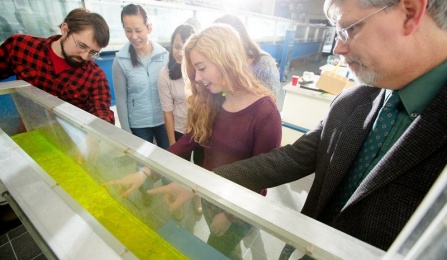Hydraulics Laboratory

The CSEE hydraulics and environmental engineering lab is located in a shared space in 120 Jarvis Hall. All CSEE students will participate in at least one lab in this space, and this is one of the several spaces that is both a teaching and research lab.
Hydraulics Lab
- Students create a visual representation of potential flow using our laminar flow table and the flow of water, ink and vacuums.
- A large water flume allows students to calculate water pressure and flow. The flume is complete with a board that can be raised and lowered, allowing for irrigation and standing wave simulations.
- Students work with different pipe systems. These stations feature pipes with different diameters, different valves, levels of friction and pressure. Students calculate the effects of major and minor losses on the pipe systems.
Location
- The hydraulics and environmental engineering labs are located in 120 Jarvis; the same building as the environmental engineering faculty.
- Within 120 Jarvis, there is a rotating lab. Within the middle of the room is a scale model of Lake Ontario. The pit is filled with water and spinning the room simulates the Coriolis Effect. This is the only rotating table, used for research on the Great Lakes in the world.
Contact the CSEE Undergraduate Office (Environmental)
Director of Undergraduate Studies, Environmental Engineering
Dr. Ning Dai
231 Jarvis Hall
ningdai@buffalo.edu
Undergraduate Academic Coordinator
Ms. Amanda Allen
212D Ketter Hall
arallen2@buffalo.edu